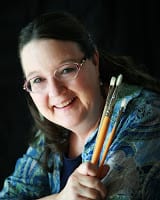
To my mind, no one paints glass better than Dianne Massey Dunbar. Her depiction of things transparent is very carefully observed and yet painted with such intuitive confidence, dexterity, boldness, clarity, and excitement that one just marvels at her ability.
I first interviewed Dunbar in August 2012, and at that time only revealed half of the interview. Now, with a few additional questions, here is the remainder of that amazing interview.
Read Part I of Dunbar’s interview here
What would be your definition of art?
To me, art in its broadest sense includes music, dancing, acting, photography, painting, writing, and the like. It is a personal expression of oneself that generally involves creativity and honesty and an audience. It almost always requires a degree of skill. It is also, invariably, the end result of a process.
Narrowing the definition to drawing and painting, to me art is the creation of an image personal to the artist that is intended as a visual dialogue with an audience. When I stop and contemplate art, it is easy to think of eloquent paintings that have been carefully designed and executed. However, I have seen many rough drawings by children that have deeply touched me. So, I guess I would say that if a painting or drawing reasonably incorporates the principles of drawing and design and craftsmanship, and further inspires in me as a viewer a sense of awe or excitement, interest, beauty, or involvement…and if it is intended to be art, I would call it art.
Are you saying then that you believe art is really in the eye of the beholder?
In my opinion, everyone is entitled to his or her own definition of art. For me personally, I agree and disagree with the statement “art is in the eye of the beholder”. That phrase seems to infer our personal likes and dislikes. I do believe that our tastes influence what we enjoy in the way of art, if we are attracted to a particular painting, whether we like thick or thin paint, still life or landscapes, realism or abstract. It is our emotional response to a painting.
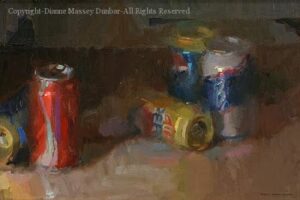
Can there be art if it doesn’t communicate with an audience, in other words, if it can’t be understood?
In order to answer this, I need to define “understood”. One might not recognize the objects in a drawing or painting, or fully understand what the artist was trying to accomplish or communicate, but that does not mean it’s not art. For example, a person that is not versed in biblical stories might not understand religious art. However, I think most people would agree that there are numerous examples of wonderful religious art. Another example is prehistoric art. I may not understand the symbols, recognize the figures or the animals, but I can still appreciate the lines and design. And, many people do not enjoy abstract art but once again that does not discredit it. Understanding a painting has absolutely nothing to do with the subject matter, and everything to do with the visual elements and execution of the painting. So, even if I do not understand the subject matter, I can still appreciate the shapes, the drawing, the lines, the texture, the design, and in that way it still communicates with me.
To be art it must be able to be understood from a purely rational point of view and be organized to create a visual statement. If a drawing or painting is so disorganized that I am unable to understand the visual elements, then I do not think it meets any definition of art. All art, including abstract art, must have drawing, shapes, and values. One can study the painting to see if it is balanced, and if the values and composition are working. Lacking any visual organization so that there are no shapes, values or drawing, well, it would be difficult to call it art.
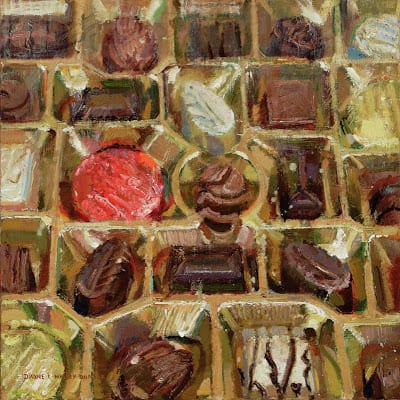
Do you consider the process of painting more important than the result?
I think they are rather inseparable. If the result is a finished painting, you can’t have the result without a process of some sort. And, at some point in time the process of painting ends in a finished piece. I will say that for me, the process greatly influences the result, which includes all my preparation before I begin a painting. I will also admit that for me the most important part of the actual painting is the beginning, because it will set the tone for the remainder of the painting.
No, what I mean is…Do you consider the act of painting itself…one’s personal joy in applying paint, experimenting and creating…more important than the physical result?
I wish I could answer yes to that question because it would be so freeing to let go of the end product and simply enjoy the process of painting. Also, if creating art was merely the act of painting with no regard for the outcome there would not be the inherent fear of failure or the discomfort when we are outside our comfort zone. However, being a professional artist is a career, a business, and so one must consider the end result as well. I think that there needs to be a balance between the creative process and respect for the end result. If it is all about the act of painting, experimenting and being creative, which incidentally can be quite frustrating on occasion, then we are on a journey that does not go anywhere. If it’s all about the end result, I think over time we become bored, don’t take risks, become too comfortable and our art grows stale and predictable. So, I think the process and the end result are inseparable, and I can only hope that as I paint I am aware of and can appreciate the joy and frustration of creating.
Where does creativity come from and how can it be nurtured?
I believe that creativity is a gift from God. I also believe we all have some degree of creativity and that creativity is not reserved for artists, musicians, actors, writers and the like. Everyone from plumbers to lawyers, teachers to advertisers and to builders, all encounter problems that require creativity to resolve. Mulling it over, it seems to me that creativity is often the result of problem solving, curiosity, need, a willingness to explore and a desire to be creative. Creativity also requires imagination and an open mind. To nurture creativity, we need to emphasize and value exploration, give others enough tools and knowledge to be able to explore different options, and offer problems that require imagination and problem solving.
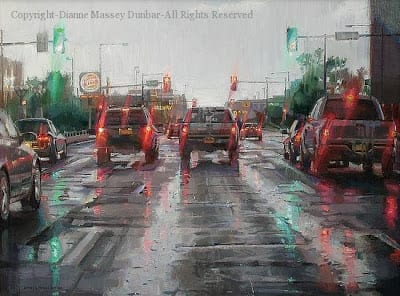
You said in our first interview that you love to play with paint…to smear it, scrape it, splatter and flick it…using all manner of tools. Were you a pretty creative child?
Probably yes. I was rarely interested in playing with dolls or dress up although I loved stuffed animals. What I really liked to do was make things. So I played with Lincoln Logs and Tinkertoys. I had a small tool set with a hammer and saw, and I would use wood and nails to build things. One Christmas I was given a wood burning set so that I could decorate the things I made. I liked crayons. I started drawing at the age of six, and started art lessons and oil painting at age seven. I also use to write…primarily poetry.
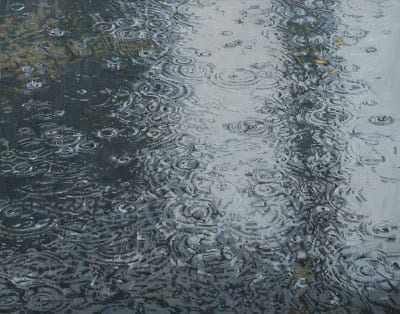
How does your work reflect your personality?
First off, I think I am somewhat sentimental, so much of my work is derived from my life experiences. It is my impression that no matter who we are or what we do, most of life is lived in the ordinary, not in the extraordinary. I think there is something special, maybe even sacred, about the ordinary stuff of life. I want to somehow honor those things we use or images we see in our daily lives that often go unnoticed. I appreciate the ketchup bottle I pulled out of the refrigerator nearly every day when my sons were young. I can find beautiful colors in simple jars. There are surprising greens in a stack of French fries. The world is full of wonderful shapes and color everywhere, even where least expected. I hope that people can see the world a little differently as a result of my painting.
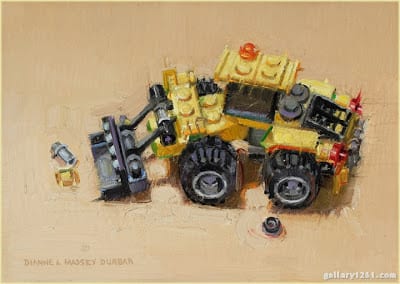
How does one find their individuality as an artist?
I would say finding individuality is a process. Where you begin will likely be very different from where your journey of art ultimately leads you. I also believe that individuality is a result of passion, excitement, exploration, risk taking, failing, succeeding, practicing, and honesty. Paint the subject matter that excites or interests you. Play with paint. Splash it, brush it, knife it, smear it, and make puddles. Try different surfaces because I am learning that they too make a difference. Be creative because after all, we are artists. Some paintings won’t succeed but will boost you to the next painting. Eventually you will have enough paintings behind you, that instead of you finding your individuality, I imagine your individuality will find you.
You use a very extensive palette of colors. How do you manage to maintain control of the color harmony in your paintings?
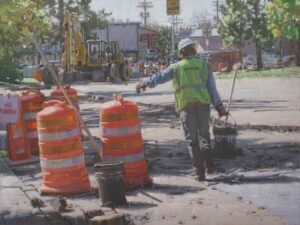
What advice do you have for a young artist/painter?
Making art is a journey and not a sprint. There are no real road maps beyond practicing and attempting to master the basic skills involved. It requires a great deal of passion, commitment, dedication, practice, and courage. Along the way there are wonderful highs and times of utter frustration. Being an artist is not at all what one envisions being an artist should look like. I believe it is about 85% work, 10% fun, and 5% inspiration. Also, I am not at all sure that we choose being artists. I rather think art chooses us. I cannot imagine not painting.
Primarily, I would suggest that you practice drawing. Drawing is absolutely essential to whatever type of art you eventually choose to do. Painting is nothing more or less than the completion of shapes. You need shapes to put value and color on. Those shapes need to be drawn, whether you do abstract art or representational art. I cannot stress the value of drawing enough. Also, if you are having problems with a painting, check your values. I have found that color can be rather forgiving, and that a problem with a painting is more often a value issue. Experiment, play, scrape, and learn what paint does (and doesn’t) do.
Find a mentor; an artist that is better than you, whose opinion you trust and who is willing to critique your work and offer suggestions along the way. Avoid asking others what they think of a painting or project, for opinions are as varied as the weather…and often not helpful. So, get a mentor/teacher to help with this process. Learn from your failures. Take those to your mentor as well.
Don’t be too quick to approach galleries. Everyone wants to be represented by a gallery and many young artists make it their goal to be invited into galleries. Instead, your goal should be to focus on your art and make it as outstanding as possible.
Lastly, keep some of your early work. I have a painting up in my studio from several years ago. When you get discouraged, and you will at times, look at that painting and spend a minute being proud of your progress.
Finally, be aware and prepared for the fact that painting is expensive and for most of us it takes time and practice to get to the point of earning any money.
Leave a Reply